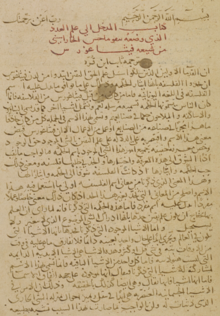Nicomachus
Nicomachus of Gerasa | |
|---|---|
Multiplication tables |
Nicomachus of Gerasa (
Life
Little is known about the life of Nicomachus except that he was a
Philosophy
Historians consider Nicomachus a
Metaphysics
Although Nicomachus is considered a Pythagorean,
Works
Two of Nicomachus' works, the Introduction to Arithmetic and the Manual of Harmonics are extant in a complete form, and two others, a work on Theology of Arithmetic and a Life of Pythagoras survive in fragments, epitomes, and summaries by later authors.

Introduction to Arithmetic
Introduction to Arithmetic (
Nicomachus's presentation is much less rigorous than Euclid centuries earlier. Propositions are typically stated and illustrated with one example, but not proven through inference. In some instances this results in patently false assertions. For example, he states that from (a-b) ∶ (b-c) ∷ c ∶ a it can be concluded that ab=2bc, only because this is true for a=6, b=5 and c=3.[9]
Boethius' De institutione arithmetica is in large part a Latin translation of this work.
Manual of Harmonics
Manuale Harmonicum (Ἐγχειρίδιον ἁρμονικῆς, Encheiridion Harmonikes) is the first important music theory treatise since the time of Aristoxenus and Euclid. It provides the earliest surviving record of the legend of Pythagoras's epiphany outside of a smithy that pitch is determined by numeric ratios. Nicomachus also gives the first in-depth account of the relationship between music and the ordering of the universe via the "music of the spheres." Nicomachus's discussion of the governance of the ear and voice in understanding music unites Aristoxenian and Pythagorean concerns, normally regarded as antitheses.[10] In the midst of theoretical discussions, Nicomachus also describes the instruments of his time, also providing a valuable resource. In addition to the Manual, ten extracts survive from what appear to have originally been a more substantial work on music.
Legacy
Late antiquity
The Introduction to Arithmetic of Nicomachus was a standard textbook in Neoplatonic schools, and commentaries on it were written by Iamblichus (3rd century) and John Philoponus (6th century).[1]
The Arithmetic (in Latin: De Institutione Arithmetica) of Boethius was a
Medieval European philosophy
The work of Boethius on arithmetic and music was a core part of the Quadrivium liberal arts and had a great diffusion during the Middle Ages.[13]
Nicomachus's theorem
At the end of Chapter 20 of his Introduction to Arithmetic, Nicomachus points out that if one writes a list of the odd numbers, the first is the cube of 1, the sum of the next two is the cube of 2, the sum of the next three is the cube of 3, and so on. He does not go further than this, but from this it follows that the sum of the first n cubes equals the sum of the first odd numbers, that is, the odd numbers from 1 to . The average of these numbers is obviously , and there are of them, so their sum is Many early mathematicians have studied and provided proofs of Nicomachus's theorem.[14]
See also
- Superparticular number
- Superpartient number
Notes
- ^ a b c d e f g h Dillon 1996, pp. 352–353.
- ^ a b c d Midonick 1965, pp. 15–16.
- ^ Eric Temple Bell (1940), The development of mathematics, page 83.
- ^ Frank J. Swetz (2013), The European Mathematical Awakening, page 17, Courier
- ISBN 0-486-20429-4, pp 58, 129.
- ^ a b c d Dillon 1996, pp. 353–358.
- ^ Plato, Timaeus 27D
- ^ Nicomachus, Arithmetica, ii. 6. 1.
- ^ Heath, Thomas (1921). A History of Greek Mathematics. Vol. 1. pp. 97–98.
- required)
- OCLC 1066603.
- OCLC 1016025625. Retrieved May 16, 2021.
- S2CID 125741349.
- ^ Pengelley, David (2002), "The bridge between continuous and discrete via original sources", Study the Masters: The Abel-Fauvel Conference (PDF), National Center for Mathematics Education, Univ. of Gothenburg, Sweden
Bibliography
Editions and translations
Introduction to Arithmetic
- Nicomachus, of Gerasa; Hoche, Richard Gottfried (1866). Nicomachi Geraseni Pythagorei Introductionis arithmeticae libri II (in Ancient Greek). Lipsiae : in aedibvs B.G. Teubneri. Retrieved 16 April 2023.
- D'Ooge, Martin Luther; Robbins, Frank Egleston; Karpinski, Louis Charles (1926). Nicomachus' Introduction to Arithmetic. Macmillan. Retrieved 16 April 2023.
Manual of Harmonics
- Jan, Karl von; Nicomachus (1895). Musici scriptores graeci. Aristoteles, Euclides, Nicomachus, Bacchius, Gaudentius, Alypius et melodiarum veterum quidquid exstat (in Ancient Greek). Lipsiae, in aedibus B. G. Teubneri. pp. 209–282. Retrieved 16 April 2023.
- Andrew Barker, editor, Greek Musical Writings vol 2: Harmonic and Acoustic Theory (Cambridge: Cambridge University Press, 1989), pp. 245–69.
Primary sources
- Iamblichus (January 1989). Gillian Clark (ed.). On the Pythagorean Life. Liverpool University Press. ISBN 9780853233268.
- Photius, Bibliotheca
- Anonymous, Theology of Arithmetic
- Boethius (1488). De institutione arithmetica (in Latin). Erhard Ratdolt. p. 110. Archived from the original on May 16, 2021 – via Internet Archive.
References
- Dillon, John M. (1996). "Nicomachus of Gerasa". The Middle Platonists, 80 B.C. to A.D. 220. Cornell University Press. pp. 352–361. ISBN 978-0-8014-8316-5. Retrieved 16 April 2023.
- Midonick, Henrietta O. (1965). The treasury of mathematics: a collection of source material in mathematics edited and presented with introductory biographical and historical sketches. Philosophical Library. pp. 15–16.
External links
- O'Connor, John J.; Robertson, Edmund F., "Nicomachus", MacTutor History of Mathematics Archive, University of St Andrews



